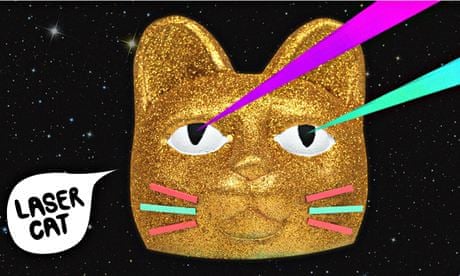Why did the tech-age sitcom The IT Crowd end? I've no idea, but I like to think it had something to do with the speed of change in the 21st century. No sooner had Graham Linehan's scripts nailed one phase of the internet than suddenly they were out of date, as a whole new set of memes took over the asylum. Today, this recent comedy programme already looks quaint. You mean people used to use "laptops"?
The world is changing too fast for comedy. Is it also changing too fast for art?
When it comes to art, the rapidity and scale with which technology is remaking our world naturally leads us to expect great things. So where are they?
Well, here's one contender for the title of digital art sensation of 2014. A couple of designers have come up with an installation called Laser Cat that has been hailed by Wired magazine. It's a giant cat that curates artworks and beams them out of of its eyes. It is a follow-up to the same duo's work Lionel Richie's Head, which allowed festivalgoers to enter Lionel Richie's head.
Christ, I don't even know what is digital about these efforts, except the creators say they reflect internet memes. "Cats are really big on the internet..."
I am obviously mistaken about The IT Crowd. The author is clearly still writing it, but he has gone underground and infiltrated his fictions into the pages of Wired magazine. Laser Cat is such a brilliant parody of unthinking trendiness. For a moment there I thought it was real.
Stuff like this gets taken up in the media because it sounds so down with the internet age. But culture does not work like that.
History shows that technological changes do not reshape art, thought or creativity in the simple way we imagine. Theorists have even come up with a term, "technological determinism", for the delusion that new technology in itself is what changes culture.
When printing was invented in the 16th century, it gave artists new ways to spread their work but it did not change the basic values of art itself. Even photography, the most radical change to visual image making in history, took more than a century to really transform the world of art.
Obviously, artists do respond to new technology, but it takes time. Real art comes from within. It has soul. There is a time lag for technology to be absorbed and experienced to the degree that soulful art can be made with it.
Video art is the obvious example. Television became universal in many places in the 1950s, but it took until the 1970s for artists to start making worthwhile experimental art with it. And it was not until the 1990s that such experiments entered the mainstream.
I reckon we will start to see the really intelligent, serious art of the digital age in about five to 10 years. On the other hand, the technology may have already changed so much by then that art cannot catch up.
In that case, we may be stuck with Laser Cat as this century's answer to the Shock of the New.

Comments (…)
Sign in or create your Guardian account to join the discussion